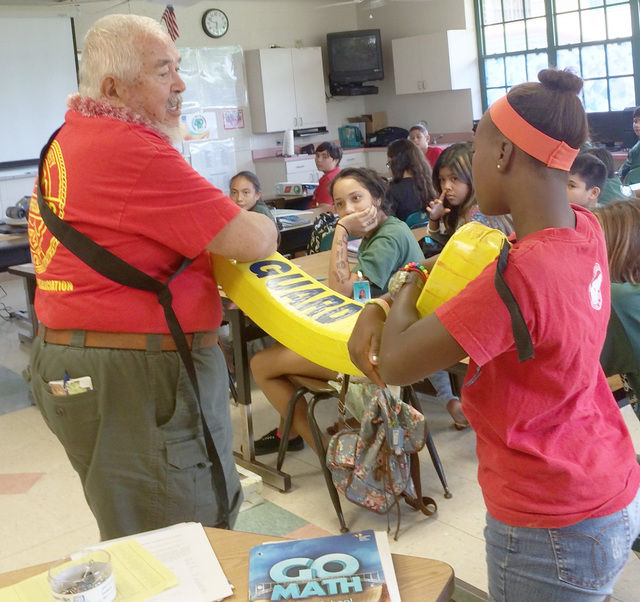LIHUE — Drowning is a real danger when you are on an island. It doesn’t matter if you’ve lived on Kauai your entire life, or if you’ve just arrived for vacation, waters on and surrounding the island can be dangerous
LIHUE — Drowning is a real danger when you are on an island.
It doesn’t matter if you’ve lived on Kauai your entire life, or if you’ve just arrived for vacation, waters on and surrounding the island can be dangerous and unpredictable.
In the past five years, there have been 46 drownings in Kauai waters. Thirty-four were visitors, 12 people were residents. The most recent was 31-year-old Jamie Zimmerman of New York, who drowned on the North Shore Monday.
Jim Jung with the Kauai Lifeguard Association spoke of the tragic event in his presentation at Chiefess Kamakahelei Middle School’s career day Friday.
“Some people are aware of the dangers, but they risk it anyway and sometimes it doesn’t pay off,” he said.
In Jung’s three, half-an-hour presentations, he stressed that Kauai may be beautiful, but it’s dangerous and the rugged landscape needs to be respected.
“People travel to Kauai and they think it’s safe because all the tourists go here,” Jung said. “They think it must be like Disneyland, but it’s not.”
Most of the students who heard Jung’s presentations spend a lot of time in the water surfing, boogie boarding, and swimming, but some of them didn’t know about the dangers that come with water sports.
“I learned about rip currents and that if you don’t know how to swim very well, stay near a lifeguard,” said Hazie Williams, 12.
Jung said there are many reasons why a day in Kauai’s wilderness could turn into a tragedy.
“Some people are aware of the risk and choose to take it anyway, some people overestimate their abilities, and some people have physical problems, like a medical condition,” Jung said. “There are lots of reasons why someone could drown.”
Swimming and adventuring alone is another reason that people get into trouble, Jung said. He recommends bringing a buddy when you go hiking or swimming.
“Sometimes people are out and about and they’re alone and they don’t pay attention to signs,” Jung said. “Then something happens and they panic and there’s no one around to help them.”
Sometimes it’s something as small as a slippery rock that causes a drowning, Jung said, and crossing streams in the wrong conditions can be just as dangerous as swimming.
“A tourist may walk out onto the rocks to get a better picture of the scene and then a wave will come in and wash them off of the rocks,” Jung said. “They could fall, hit their heads, get caught in a rip current.”
Rip currents, which can carry anything caught in their path out to sea, are the culprit behind some of the drownings on the island, Jung said. Tthe best way to escape a rip current is to not try to escape at all, he said.
“Don’t fight it, just go with the flow,” Jung said. “It’ll take you out and you just go out and wait for help after you’re released.”
Jung said if you’re a strong enough swimmer, you might be able to escape the rip current by swimming perpendicular to the current, but that technique doesn’t work for everyone.
“The most important thing is not to panic and not to hyperventilate,” Jung said. “Stay calm and signal for help.”
Jung said many times people get caught in rip currents because they mistakenly perceive those places on the beach to be safe.
“Tourists that aren’t used to walking barefoot come across this nice, soft, sandy spot and think it’s a great place to swim,” Jung said. “Before you know it, they’re carried out by a current.”
While it’s good to keep an eye out for rip currents yourself, Jung said Kauai’s lifeguards are knowledgeable on the currents and can point them out.
Swimming with a lifeguard nearby is another safety measure Jung stressed to the students.
“Lifeguards know how to identify someone in distress,” Jung said. “If you’re already floating face-down, they can bring you ashore and give you CPR.”
Lifeguards go through continuous training to be ready for dicey situations and they study the patterns of the waters that surround Kauai.
Kauai lifeguards made over 92,000 drowning preventions in 2013, which means they were giving advice and telling people where to swim. That same year, 472 people were actually saved from drowning situations.
“Aren’t those good reasons to swim near a lifeguard?” Jung asked.
Jung encouraged students to join KLA’s junior lifeguard program.
“You know, this really isn’t necessarily about a career, but I’m presenting this on career day anyway and it’s important,” Jung said. “If you go out there and drown, you won’t be getting a career. It’s important to know water safety so you can have a career and a good life.”


